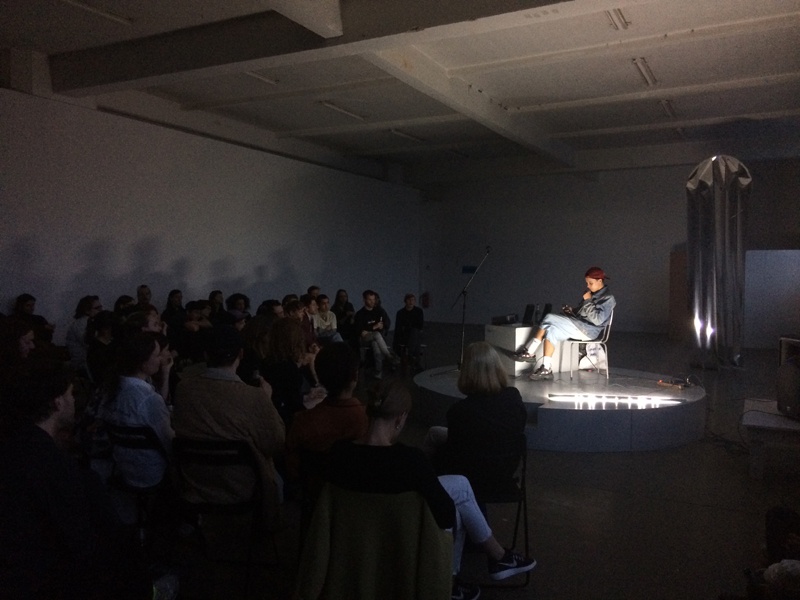Hearing Voices On the reading and performance of poetry

Young Girl Reading Group #113, Ausstellungsraum Klingental, Basel, 2016
One mode of reception that plays a key role in our exploration of artistic writing in this issue is reading – or rather, the state of “being read”: a perspective that highlights what significance publishing and various modes of “sharing” might have on the act of authorship itself.
In her analysis of this phenomenon, Karolin Meunier takes Berlin-based writer Haytham El-Wardany’s book “How to Disappear” as a key example, one that perhaps not incidentally recalls Seth Price’s novel “How to Disappear in America.” As the latter records Price’s disappearance amid the textual registers native to the Internet, El-Wardany’s work, Meunier argues, in its consideration of reading silently versus reading aloud, destabilizes both the boundaries of the self and the idea of possession itself – including, not least, the subject’s possession of his or her own voice.
A text, in being read, always suggests its own performance, and with this, the possibility of its actualization and expropriation. When you consider writing from the perspective of reading, the most difficult element to account for is the voice. The voice is performative; it rewrites the text; it engenders its own presence, and in doing so, it takes a stance toward the time of its writing that is both productive and distanced. This is true, also, for any silent act of reading. [1] Many younger authors – Hannah Black, Hanne Lippard, or Ruth Buchanan, for instance – use their literary-artistic practice to react to the tension created between, on the one hand, the constant, ever-regenerating, silently scrolling flow of text that appears on monitors, exhibition displays, and publications; and, on the other hand, the need for temporary gatherings, the need to act out and consolidate text through speech. Nevertheless, the ties between poetry and performance considered in this essay – with all the pop-cultural, activist, and academic considerations that live performance suggests – are not merely symptomatic of a tendency toward a greater sense of immediacy, neither in the interest of ephemerality or authenticity. Instead, the question arises how contemporary performances of language and subjectivity are being approached. This question presumes a critical relationship toward the role of participants and readers, whose involvement consists of receiving the performances from a perspective that, while separated from the performance, is nevertheless not passive.
We might consider the author Haytham El-Wardany here. Raised in Cairo and based in Berlin since the 1990s, he composes his short stories and prose texts in Arabic. In recent years, his works, increasingly, have been translated and presented in the art context – not least on account of their conceptual nature, and also the author’s own interest in a form of writing that takes leave of its primary terrain. In El-Wardany’s “How to Disappear,” an investigation of the auditory by way of the instruction manual form, he writes while describing the voice that is active (if not audible, per se) when one reads, claiming that it cannot be compared with either the sound of one’s own speech nor with the general “voice of history, or of truth, or one of the authors.” [2] Herein, he invites readers to perform a series of exercises, e.g.: “In the third session, read what you like of poetry. Let it be the work of Salah Abdel Sabur.” Over the course of these exercises, he develops the idea of understanding this inner reader, which is at once both atemporal and disembodied, as more than just a contemplative and self-immanent act that appropriates the specific context and inflection of a text for itself. The point is made that even one’s own voice isn’t one’s own possession – it does not claim ownership over, nor yield to, other people’s texts. Rather, he suggests, this voice is the prerequisite for the temporary dissolution of a structured subjectivity: “This means that […] the voice in which the self declares its presence [and] bespeaks ideas, emotions, and memories [is] not specific to you but rather to the author. Contemplate the fact that your inner voice, at this moment, is nothing more than the voices of others that have become part of you.” This theory of permeability is articulated more forcefully as a political concern in the book’s second, narrative section, “Sounds of the Middle Classes,” which focuses on noise and retreat, on participation in and sequestration from the noises of the city, and on practices of deregulation. With El-Wardany’s essay, we can trace both the possibilities as well as the fragilities suggested by an open structure of voice, person, and text. Reading, in this structure, appears to be a kind of distribution model, one whose qualities are found in the performative superposition of different perspectives. Who is ultimately heard in what context, however, remains an expression of socially encoded boundaries of demarcation.

Henriette Heise, "iPhone 5 Matter,“ 2013/14
At this year’s Forum Expanded, the artistic section of the Berlinale film festival, [3] El-Wardany was invited to give a reading from the “Hanging Garden of Sleep,” his poetic investigation of sleep as a form of withdrawal and transformation. The event didn’t take place as part of the festival’s discussion program, but instead was hosted in a movie theater, between two short films. The original text was read aloud while the English translation was projected onto the screen. In a more intense way than even a subtitled film, this presentation encouraged the non-Arabic-speaking segment of the audience to follow the abstract sounds of the words. And the theater was converted into the kind of public space in which, as described in the “Hanging Garden of Sleep,” the sleepers withdraw from the shared activities of society and simultaneously demonstrate a “faith in the random other.” [4]
One possible reason for the number of public readings at the moment – particularly, in conjunction with art exhibitions, artists’ book fairs, and self-organized events – might be (aside from the public reading’s place in the contemporary event-culture economy) an effort to create a similar instance of productive risk in the reciprocal consigning of one’s own self over to the other. In this context, the kinds of positions that stand out are primarily those in which a person and their speech are not entirely equivalent – positions that suggest one is watching something other than the reenactment of a printed text by its author. In these acts of reading and being read, and their respective conditions, lies reference to both the constructedness of what has already been written as well as its alterability. As the voice interprets the text, a moment of shared bodily presence is revealed, generating a connection to the situation of writing – each part transpiring at different times and under different conditions but nevertheless both oriented toward a future, unforeseeable public. Even in written literature, this development can be identified within poems and prose texts that carry the provisionality and constructedness of what has been written – that is, prose that itself performs the rupture within and with language in the form of finished texts, thereby opening up a further aesthetic dimension of this form. [5]
One notable non-institutional Berlin outlet via which such experiments with literary formats are being performed is the event series “After the Eclipse,” [6] organized by Ebba Fransén Waldhör, Imri Kahn, and Sarah M. Harrison. At a typical reading in this series, multiple authors present short texts one after another, many presented here for the first time, if not also produced especially for the occasion. The authors read the works off laptops, cell phones, and printouts. And the readers are also listeners. Further, such events don’t seem to necessarily focus on finished books or a curated program, but instead convey a commitment to a jointly shared public space and the urge to define this oneself. In the novella published by Harrison earlier this year, she does not cast the protagonists as part of any predefined scene, only as figures radiating a generalized, slacker--bohemian nonchalance on their path through a large Western city. The novella has an unusually negative inflection, yet the figures aren’t psychologized or evaluated. As with other works by -Harrison, the characters’ spoken dialogue and interior monologues frequently fall apart into scattered sentences – sometimes rants, other times concrete odes to the profane.
“All the Things,” the title of this novella, was put out by the London-based publisher-gallery Arcadia Missa, which also co-published Hannah Black’s anthology “Dark Pool Party.” [7] Both books are high-paced in different ways, yet both set a tempo derived from the virtuosity with which their respective authors handle everyday speech, returning this language to their readers as if by a sharp echo. Harnessing what is, in a sense, a collectivized voice, they offer a strategy for how an author might resist their readership’s tendency to consume the writer’s personality along with the work. In Black’s writing, the same is true in regards to the vocabulary of academic and art-critical discourse, and the hierarchies that are manifested within it. By approaching this at a conceptual proximity, but using literary means, Black negotiates the parameters under which certain conflicts are discussed – as well as the archetypal character of artistic positions in curatorial and theoretical concepts. For example, in Black’s short text “Atlantis” (published in “Dark Pool Party”), she politicizes the use of analogy, complicating its use within the poetic method as a rhetorical device that is both self-evident and unavoidable.
If one thing can always stand for another, this can potentially set off an endless chain of comparisons, which renders specific experiences either generic, shrouded, or devoid of meaning. “This is in spite of the category’s obvious problems: being made an example of, becoming fungible. […] It is not that I think we are tasked with imagining or hypothesizing another world; it sits on this world’s shoulder; it is its parrot, its angel, but metaphors are banned in the war on analogy, too. I think that blackness and maybe also labor, considered now through the enslaved person as well as the worker, hover in this banned limbo.” “Dark Pool Party” is a collection of shorter-format pieces, which follow a loose narration ranging from the poetic and personal, to the analytical. In this text, Black tells of an invitation to make a work for a group exhibition in Atlantis – here, a mythical curatorial world of ideas without context, where the depiction of real crises is suspended in favor of comparatively impotent “global and identical forms.” Black’s analogy also points to another stage, however: language as the instrument of a white and, above all, male pretension to abstraction.

After the Eclipse, Flutgraben e.V., Berlin, 2015
Much of Black’s work is created with the intension of being read live (including, at events such as “After the Eclipse”) or to be broadcast via livestream (as with her recent performance in central Hamburg for the What Time Is It on the Clock of the World* festival). [8] The speed and unique musical rhythm Black employs when performing her texts highlights their compositional qualities in their specific relationship to spoken language. It is a form of incompleteness paired with simultaneous presence, one that refuses to lightly absolve the audience of its responsibility to be an active listening body.
To allow the written word a state of maneuverability (something that is usually only granted to speech) is to insist on an openness to accidents, and to the urgency of the spoken form and its effects. This quality is something that aligns with the desire, within contemporary art, for “text” and its performance. Speaking in a language (e.g., English or German) that some sector of the reader’s public or the reader him/herself may not fully understand, reading at times repetitiously, extremely fast, or very slow, or using technical devices to delay one’s speech – these are all possible formal variations that simultaneously mark disconnections. They convey the vunerable and unstable [9] correlations between person, voice, and text in relation to the public.
Ian White, in his practice as an author, artist, filmmaker, and teacher, always insisted on the importance of the present, and handled this discursively. [10] In a discussion conducted as part of a 2011 performance series at the Kunsthaus Bregenz, White introduced the concept of a “provisional community” that participates not only in the moment of rendition but also in the production of a work: “For me, the making also occurs in the live instance. It is not that the live instance is solely the dissemination or publishing of something already made. […] The meaning of the work being also in part contingent upon being shared in this way” [11] In the multitude of decisions made in the moment of performing, there is a moment of actualization that doesn’t always proceed smoothly, and mustn’t always be comfortable. This is because the viewer not only projects an experience of productive participation, but at the same time a revocation of presence – a separation from what is being acted out. Within this tension, “the provisional can accumulate,” as Emma Hedditch suggested in the same conversation. And using this, as performer, one can “be able to have a temporary moment that people understand as temporary.” [12] The work of both artists has often pushed language to the limits of comprehensibility, for example how some of Ian White’s performances generated a backdrop of overlapping voices and an image surface overlaid on the text, or in Emma Hedditch’s practice, her collectivizing and anonymizing of the speaker positions. At the same time, these are not strategies of mystification; instead they provoke a poetics of attention for specific situations – attention to the hierarchies between those who speak and those who listen, attention to bodily postures and the distribution of space, attention to institutional politics of inclusion and groups of friends, attention to the feelings that emerge, and to the different experiences and possibilities opened up in this provisional community (which also depend on the cultural and gender attributions that, whether openly or covertly, are being performed). “The image, description brings force, recognition. Free excitement, a coinciding with themselves. Not the way of looking or how they look, with an in-built mechanism of understanding codes signs or familiarity. The image description a reading, imagining image. The image of our being near to each other is just an image. It is however generative, trusting a signal.” [13]

Ebba Fransén Waldhör, untitled, 2016. (illustration for Hanna Black‘s "Dark Pool Party,“ 2016)
For the artistic positions described here, the perspective from which one speaks is often one that is addressing at the same time – it is personal, but not in a way that is identical with the self, as if this perspective is tied solely to the experiences of the author and can be split off from the listeners. Its relationship to the audience is much more akin to a confrontation. This, perhaps, also suggests a reaction to the crisis of first-person narratives, or at least the need for them to be recalibrated in a way that defies the logic of a merely narcissistic, ahistorical claim to one’s own “history” and its appropriation as material for others to spectate. Returning to Hannah Black, her recent article “The Identity Artist and the Identity Critic” outlines in precise terms the contradictory implications of arguments founded in identity politics: “This form of identity politics affords no materiality to history (which is a word for collective experience) beyond the narrow boundaries of the self.” [14]
Instead, the use of the “first person,” for many contemporary positions, doesn’t just refer to an “I” that subjectivizes and thereby legitimates what is being said (as has been established primarily in feminist writing approaches); nor does it necessarily refer to a “lyrical self” that is dissolved in metaphor. If the author is present in the performance of the text, another space to negotiate is opened up in the visible and audible differences between text and speaker. In this presence, the possibility indeed exists of fetishizing the reader, but the insistence on presence also serves to materialize the performances of the text and incorporate them into the artistic work. Knowing that both the pronouns and the person performing them can be exchanged provokes a form of presentation that complicates this process, so long as the reading voice insists on the nowness of the concrete situation – as provisional as it very well may be.
Translation: Rob Madole
Notes
| [1] | On the relationship between reading and being read, also see the discussion of Eva Meyer’s book “Legende sein” in this issue. |
| [2] | All citations from: Haythem El-Wardany, How to Disappear, transl. from the Arabic by Jennifer Peterson, 2013. The book is the first part in a series of how-to manuals, edited by Maha Maamoun and Ala Younis at Kayfa ta. |
| [3] | The Forum Expanded was curated by Stefanie Schulte Strathaus/Anselm Franke/Nanna Heidenreich/Bettina Steinbrügge/Ulrich Ziemons. |
| [4] | Haytham El-Wardany, “The Hanging Garden of Sleep” in: Starship, 14, 2016. |
| [5] | Authors like Monika Rinck, with her poetry volume “Honigprotokolle. Sieben Skizzen zu Gedichten, die sehr gut sind,” Berlin 2012, in which she repeatedly uses the same or similar beginnings of sentences and chains of words. Also Anne Boyers’ poem “Questions for Poets,” consisting only of questions and an extensive section of footnotes. Available in: Anguish Language: Writing and Crisis, eds., John Cunningham/Anthony Iles/Mira Mattar/Marina Vishmidt, Berlin 2015. |
| [6] | The events take place in the rooms of the Flutgraben e.V. in Berlin. |
| [7] | Sarah M. Harrison, All the Things, London 2016, and Hannah Black, Dark Pool Party, London 2016. |
| [8] | What Time Is It on the Clock of the World*, Internationales Festival zu Feminismus und öffentlichem Raum, curated by Sophie Goltz, Hamburg city curator, May 2016. |
| [9] | The conceptual pairing is taken from a discussion by the artist Ruch Buchanan, in which she discusses the “vulnerable and unstable consequences” of the tension between the provisional and the specific. See: On Performance, ed. by Eva Birkenstock/Yilmaz Dziewior/Joerg Franzbecker, Bregenz 2012. |
| [10] | His position has also impacted the thinking of many who worked with him and spent time with him before his untimely death. A collection of Ian White’s essays, “Here is information. Mobilise – Selected Writings,” will be published in October 2016 by LUX in London. |
| [11] | This discussion, not open to the public, took place between nearly all of the participating artists and the curators Eva Birkenstock and Joerg Franzbecker, conducted for the publication after the event. See: On Performance, op. cit. |
| [12] | Ibid. |
| [13] | Excerpt from a poem by Emma Hedditch, sent by the author in 2015 via email with the subject “We Are the Signs and the Signals” to an unknown number of recipients. A performance script with the same title is found in her ebook published this year, “I Don’t Want You to Work As Me.” |
| [14] | Hannah Black, “The Identity Artist and the Identity Critic,” Artforum, Summer 2016. |
